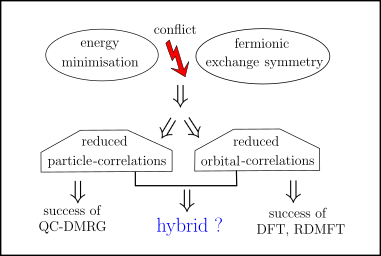Ground State Problem: A unifying Perspective
One of the most crucial challenges in physics, chemistry and material sciences is the description of interacting quantum many-body systems, in particular in their ground states at zero temperature. This concerns systems on all length scales, e.g. atoms and molecules on the microscopic scale and solid bodies and neutron stars at the macroscopic and astronomic scale.  Based on our interdisciplinary background and expertise in quantum many-body physics, quantum information theory and mathematical physics, we are working on a more systematic and more effective approach to this notoriously difficult ground state problem. To be more specific, let us recall that in realistic quantum many-body systems the electrons interact only by two-body forces and the interaction always exhibits some form of spatial locality. The consequences of exactly those two fundamental features of realistic systems shall be explored, quantified and exploited. In particular, we plan to show from a quite general perspective that it is the universal conflict between energy minimization and fermionic exchange symmetry which together with those two fundamental features enforces a significant reduction of the particle correlations and orbital correlations in ground states compared to generic quantum states (see figure).
Based on our interdisciplinary background and expertise in quantum many-body physics, quantum information theory and mathematical physics, we are working on a more systematic and more effective approach to this notoriously difficult ground state problem. To be more specific, let us recall that in realistic quantum many-body systems the electrons interact only by two-body forces and the interaction always exhibits some form of spatial locality. The consequences of exactly those two fundamental features of realistic systems shall be explored, quantified and exploited. In particular, we plan to show from a quite general perspective that it is the universal conflict between energy minimization and fermionic exchange symmetry which together with those two fundamental features enforces a significant reduction of the particle correlations and orbital correlations in ground states compared to generic quantum states (see figure).
Furthermore, it is quite remarkable that all numerical methods that were developed in the past 90 years in physics, chemistry and material sciences can de facto be grouped into two distinctive categories, highlighting their scope and fundamental limitations. On the one hand, there are methods such as the famous density functional theory and coupled cluster that are capable of dealing with strong particle correlations. At the same time, they fail, however, to recover the important orbital correlations. On the other hand, in the second category, there are methods such as the famous density matrix renormalization group ansatz that are capable of dealing with those strong orbital correlations. At the same time, they then fail, however, to recover the important particle correlations. It is thus one of our main research goals to develop a combined method which can recover efficiently at the same time particle and orbital correlations.

